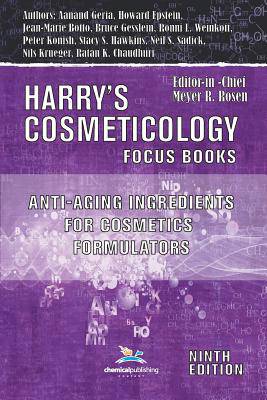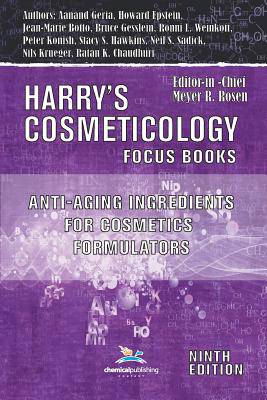
En raison d'une grêve chez bpost, votre commande pourrait être retardée. Vous avez besoin d’un livre rapidement ? Nos magasins vous accueillent à bras ouverts !
- Retrait gratuit dans votre magasin Club
- 7.000.000 titres dans notre catalogue
- Payer en toute sécurité
- Toujours un magasin près de chez vous
En raison de la grêve chez bpost, votre commande pourrait être retardée. Vous avez besoin d’un livre rapidement ? Nos magasins vous accueillent à bras ouverts !
- Retrait gratuit dans votre magasin Club
- 7.000.0000 titres dans notre catalogue
- Payer en toute sécurité
- Toujours un magasin près de chez vous
354,45 €
+ 708 points
Description
The new 9th edition of Harry's Cosmeticology is available as a 3 volume set containing over 2600 pages of new information on the recent changes in the cosmetic and personal care industry. Chemical Publishing is now offering key parts of the title for those interested in a particular subject area covered in the book. Harry's Cosmeticology 9th Edition has developed a new line of "Focus Books" for this purpose. Focus books are a series of selected chapters that can be used as a reference guide for a particular subject area. This focus book covers: TOPICAL RETINOIDS - Author - Aanand N. Geria, MD - 4.3.1.1 Introduction - 4.3.1.2 Pharmacology - 4.3.1.3 Indications - a. Acne - b. Melasma and Post-Inflammatory Hyperpigmentation - c. Photo-Aging - 4.3.1.4 Adverse Effects - PEPTIDES FOR ANTI-AGING SKIN CARE - Author - Howard Epstein, Ph.D. - 4.3.2.1 Peptides for Anti-Aging Skin Care - 4.3.2.2 What is a peptide? - 4.3.2.3 Skin Structure and Peptide Categories - 4.3.2.4 Bioactive Peptides Marketed for Skin Care Products - PART 4.3.3 - MICRORNAS IN SKIN PHYSIOLOGY - Authors - Jean-Marie Botto (Ph.D.) - 4.3.3.1 RNA interference and microRNAs timeline of the discoveries - a. Discovery of microRNAs - b. The concept of RNA interference - 4.3.3.2 MicroRNAs - nomenclature, structure, function, mechanism of action - 4.3.3.3 MicroRNAs regulate various aspects of human physiology and epigenetics - 4.3.3.4 MicroRNAs and skin physiology - a. Introduction on skin - b. MicroRNAs and cutaneous biology - c. Epidermal renewal and skin barrier - d. MiR-203 is a master regulator of epidermal differentiation - e. P63, SOCS3, Zfp281, JUN, and ABL1 are the major mir-targets in the epidermis - f. Other microRNAs important in epidermal renewal - g. Skin pigmentation - h. Dermal physiology - i. MicroRNAs and the hypodermal adipocytes - j. Hair follicle morphogenesis - 4.3.3.5 Interest of microRNAs in the evaluation in vitro of anti-aging dermo-cosmetic ingredients - a. Skin aging - b. MicroRNAs and cellular senescence - c. Tissue-engineering and microRNA studies - PART 4.3.4 - AMINO ACIDS - Author - Bruce W. Gesslein - 4.3.4.1 Overview of Amino Acids - a. Production - b. Properties - 4.3.4.2 The Appearance of Aging of Skin and Hair - a. Skin - b. Wrinkling - c. Elasticity - d. Clarity - e. Hydration - f. UV Damage - 4.3.4.3 Hair - a. Breakage - b. Dullness - c. Elasticity - d. Roughness - 4.3.4.4 Formulation for Skin Care - a. Cleansers - b. Moisturizers - c. Serums - 4.3.4.5 Hair Care - a. Shampoos - b. Conditioners - PART 4.3.5 - AHAS AND BEYOND: ANTI-AGING INGREDIENTS AND THEIR BENEFITS FOR ALL LAYERS OF THE SKIN - Editor - Ronni L. Weinkauf, Ph.D. - Peter Konish - Stacy S. Hawkins, Ph.D. - 4.3.5.1 Introduction - 4.3.5.2 Alpha-Hydroxy Acids (AHAs) - 4.3.5.3 Quantitative Clinical Benefits of AHAs - 4.3.5.4 Cellular and Structural Changes Associated with AHAs - 4.3.5.5 Polyhydroxy Acids (PHAs) - 4.3.5.6 Bionic Acids (BAs) - 4.3.5.7 Formulation Strategies for Maximizing Hydroxy Acid Performance - 4.3.5.8 N-Acetylamino Sugars - 4.3.5.9 N-Acetylamino Acids - PART 4.3.6 - CYTOKINES, GROWTH FACTORS, AND STEM CELLS: NEWEST APPROACHES TO YOUNGER LOOKING SKIN - Nils Krueger - Neil S. Sadick - 4.3.6.1 Aging - 4.3.6.2 Growth Factors and Cytokines - 4.3.6.3 Stem Cells - PART 4.3.7 - ANTIOXIDANTS IN COSMETICS FOR ANTI-AGING - Ratan K. Chaudhuri - 4.3.7.1 Background - 4.3.7.2 Causes of UV-Induced Chemical and Biochemical Changes in Skin - 4.3.7.3 Antioxidants in the Defense System of the Skin - 4.3.7.4 Consequences of UV-Induced Chemical and Biochemical Changes in Skin - 4.3.7.5 Use of Conventional and Nonconventional Antioxidants for Skin Protection and Reversal of Signs of Aging - a. Conventional Antioxidants - b. Other Photoprotectants -
Spécifications
Parties prenantes
- Auteur(s) :
- Editeur:
Contenu
- Nombre de pages :
- 200
- Langue:
- Anglais
- Collection :
Caractéristiques
- EAN:
- 9780820601854
- Date de parution :
- 10-06-16
- Format:
- Livre broché
- Format numérique:
- Trade paperback (VS)
- Dimensions :
- 152 mm x 229 mm
- Poids :
- 272 g

Les avis
Nous publions uniquement les avis qui respectent les conditions requises. Consultez nos conditions pour les avis.






